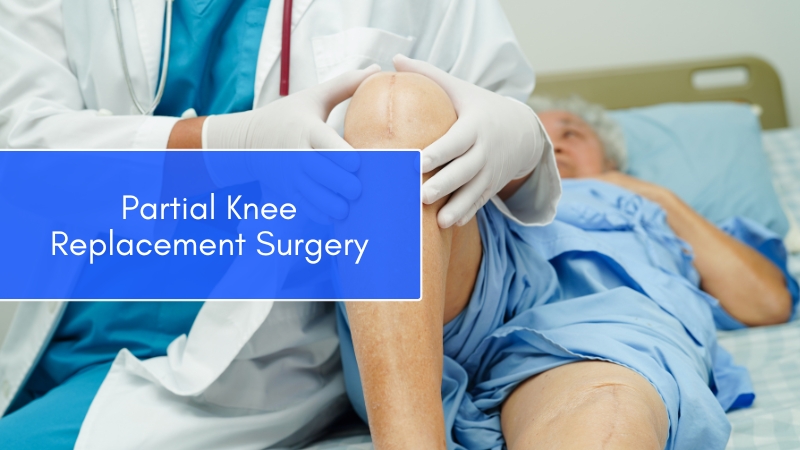A partial knee replacement operation removes damaged knee bones and muscles. Some forms of knee arthritis are common. Areas are repaired with prosthetics. Your other knee remains intact. Partial knee replacement surgery requires a good recovery time.
What is a Partial Knee Replacement?
A partial knee replacement replaces a portion of the knee. Arthroplasty repairs joints. Surgeons use metal and plastic prostheses to heal knees. Following are the two common types of partial knee replacement:
- Unicondylar knee arthroplasty (a more common procedure) replaces one knee joint surface, either medial or lateral.
- Patellofemoral joint replacement (the least common) involves only the patella (kneecap) and the damaged femur attachment.
What Kinds of Problems do Partial Knee Surgeries Fix?
Most people who get it do so because they have arthritis. Osteoarthritis affects the majority of patients with partial knee replacement. Your doctor may think about a partial knee replacement if your serious symptoms don’t get better with nonsurgical treatment.
- Discomfort in joints
- Stiffness
- Impaired knee mobility
- Swelling
Which People Can Get a Partial Knee Replacement?
Good candidates for partial knee replacement surgery typically have:
- Damage to one knee part
- Functional ligaments
- Good mobility
- General knee stability
Partial knee surgery relieves pain and improves knee function. It also reduces inflammation and aligns the knee. Top-rated knee replacement surgeons treat OA with partial knee surgery. Not all OA patients can have partial knee surgery. People who have damaged the medial (interior) compartment of their knee joint should have this operation. There are three main knee compartments: Medial compartment: inner part Lateral compartment: outer part Patellofemoral compartment: behind the kneecap
Doctors may prescribe partial knee replacement surgery for OA limited to one knee compartment, adequate knee range of motion, and no inflammatory arthritic symptoms.
Individual circumstances determine partial knee replacement therapy requirements. Orthopedic surgery doctors may also consider pain, everyday activities, and surgery outcomes.
Surgery Preparation
Preparation begins soon after the surgery consultation and lasts around a month. Therapists encourage patients to do range of motion and isometric hip, knee, and ankle strengthening. Before surgery, doctors perform tests such as a full blood count, electrolytes, APTT and PT to assess blood clotting, chest X-rays, an electrocardiogram, and blood cross-matching for transfer. An iron supplement a month before surgery may boost hemoglobin.
Correct knee X-rays establish component sizes. Warfarin and aspirin will be stopped days before surgery to reduce bleeding. If pre-op work-up is done in the pre-anesthetic clinic, patients might be admitted the day of surgery or one or more days earlier. Minimally invasive knee replacement procedures have pre-operative seminars at some hospitals.
Now, patient care includes preoperative education. It may lessen knee replacement surgery anxiety with few side effects. There is insufficient quality data to suggest pre-operative physiotherapy for older people receiving total knee arthroplasty.
How do Partial Knee Surgeries Help?
Most knee replacements are arthritis-related. Most patients who undergo partial knee replacement surgery have osteoarthritis. If conservative care doesn’t help, your doctor may suggest a partial knee replacement.
- Discomfort in joints
- Stiffness
- Impaired knee mobility
- Swelling
One of the most popular arthroplasties is total knee replacement. Around 850,000 knees are repaired annually by US surgeons. Most people with knee arthritis have disease in all three compartments; therefore, total knee replacements are more common than partial ones.
Tip to Get Ready for Knee Replacement Surgery
Your doctor and surgeon will instruct you on surgery preparation. In general, you need
- Blood testing.
- An ECG to monitor your heart.
- A dental cleaning and evaluation is necessary to prevent post-surgery infections.
- Imaging tests, such as X-rays of the knee, are necessary.
What Happens After a Partial Knee Replacement Surgery?
Anesthesia numbs and relieves pain during the operation. Usually, general or regional anesthesia puts patients to sleep or numbs them from the waist down. A knee surgeon near me, who performed your partial knee replacement, will:
- Take out any unhealthy cartilage and bone from their replacement sections.
- Put on the limbs.
- To fix the smooth cushion in your cartilage, use a plastic filler.
Partial Knee Replacement Recovery
Doctors will prescribe healing drugs. You might need a chair, crutches, or a cane to get around on your own. Physical therapists give workouts to build muscle and improve range of motion. Put your weight on your knees immediately. After going home, follow your surgeon’s orders. This includes assisted hallway and bathroom walks. Physical therapy is required for knee strengthening and range of motion. Partial knee replacement recovery time is the fastest.
Partial Knee Replacement: Pros and Cons
As with any medical therapy, pros and cons of partial knee replacement surgery exist. Discuss your requirements and goals with your doctor. A partial knee replacement has many advantages over a whole one. The surgery is easier, shorter, and smaller because it only removes damaged tissue. Blood loss, clotting, and infection are less likely. Because of decreased pain and edema, recovery is faster and easier for patients undergoing partial knee replacement surgery.
Common Side Effects and Contraindications
After partial knee replacement surgery, doctors may recommend lower limb venous ultrasonography for deep vein thrombosis screening. This screening should only occur when necessary. Cryotherapy and intermittent pneumatic compression can prevent deep vein thrombosis in people with certain medical conditions. Patients with certain infections, mental or neuromuscular disorders that increase the risk of prosthesis instability, fixation failure, or postoperative complications, skeletal immaturity, severe knee instability, or excessive body weight should not undergo partial knee replacement surgery.
Common Side Effects
Side effects: like every operation, PRK has risks. Some of the things that can cause revision are dislocation, loosening, fracture, nerve damage, heterotopic ossification, implant wear, metal sensitivity, soft tissue imbalance, osteolysis (localized progressive bone loss), and particle debris response. Knee implants may feel and behave differently than healthy joints.
Final Words
A partial knee replacement surgery involves replacing a portion of the knee with an implant. For osteoarthritis in the medial or lateral compartments, doctors propose partial knee replacement. Inflammatory or multi-compartment knee arthritis precludes partial knee replacement. Within 6 months of surgery, most patients see improvement. We have the best team of doctors, like Dr William Moore, who makes a dramatic difference in patients’ well-being. If you have any questions about a pain management in Dallas that offers the best knee surgery near you, please contact us!


